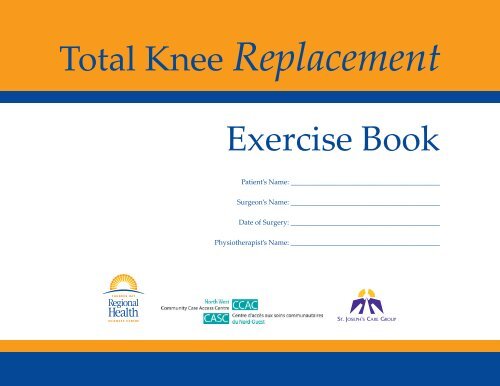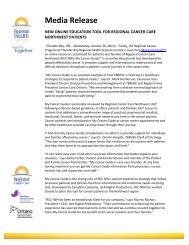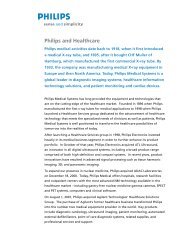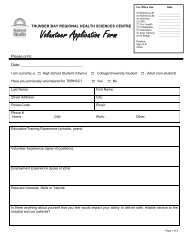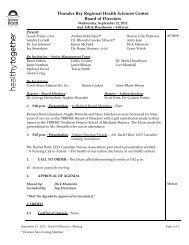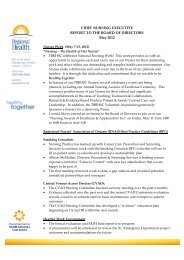Total Knee Replacement Exercise Booklet - Thunder Bay Regional ...
Total Knee Replacement Exercise Booklet - Thunder Bay Regional ...
Total Knee Replacement Exercise Booklet - Thunder Bay Regional ...
You also want an ePaper? Increase the reach of your titles
YUMPU automatically turns print PDFs into web optimized ePapers that Google loves.
<strong>Total</strong> <strong>Knee</strong> <strong>Replacement</strong><br />
<strong>Exercise</strong> Book<br />
Patient’s Name: ___________________________________________<br />
Surgeon’s Name: ___________________________________________<br />
Date of Surgery: ___________________________________________<br />
Physiotherapist’s Name: ___________________________________________
Immediate Postoperative <strong>Exercise</strong>s<br />
You may begin the following exercises immediately aer your surgery, as they are important for:<br />
• Helping to prevent complications with your breathing.<br />
• Helping to prevent blood clots in your legs.<br />
• Increasing your circulation.<br />
1. Deep Breathing and Coughing <strong>Exercise</strong>s<br />
Until you are up and moving well take at least 10 deep breaths, followed by a cough, every hour that you are awake.<br />
2. Ankle Pumping<br />
Move your feet up, down and in circles.<br />
Repeat 50 times every hour that you are awake.<br />
3. Buock Contractions<br />
Tighten your buock muscle and hold for a count of 5 seconds.<br />
Repeat five to ten times, three to four times each day.<br />
4. Static Quadriceps Strengthening<br />
Tighten the muscle on the front of your operated thigh<br />
by pressing your operated knee into the bed.<br />
2<br />
T H U N D E R BAY R E G I O N A L H E A LT H S C I E N C E S C E N T R E
Learning to Move<br />
Aer surgery, plan ahead. Take pain medication ahead of time.<br />
<strong>Exercise</strong> is a critical component of your recovery, particularly during the first few weeks aer surgery. These exercises and<br />
walking will help to restore movement and strengthen your knee. The goal is for you to be able to resume activities.<br />
Weight Bearing:<br />
Weight bearing is the amount of weight that the doctor wants you to put on your new knee. There are three different<br />
amounts. Usually your doctor will want you to fully weight bear.<br />
• Feather or touch weight- Your operated leg touches the floor enough to help you balance. Do not put any weight on it.<br />
• Partial weight bearing- Only a certain amount of weight can be put on your operated leg. Your physiotherapist will help<br />
you learn how much.<br />
• Full weight bearing- You can put full weight, or as much as you can tolerate when standing or walking.<br />
Using a Walker or Crutches:<br />
Stand up tall and look ahead while you walk.<br />
1. Move the walker or crutches forward first, followed by your operated leg. Then<br />
move your unaffected leg forward.<br />
2. Put your weight on the walker or crutches to take the weight off your operated leg<br />
when you step onto it. Follow your own weight bearing instructions when using a<br />
walker or crutches.<br />
<strong>Total</strong> <strong>Knee</strong> <strong>Replacement</strong>: <strong>Exercise</strong> <strong>Booklet</strong><br />
TOTA L K N E E R E P L AC E M E N T E x e r c i s e B o o k l e t<br />
w w w. t b r h s c . n e t<br />
3
How to Manage Stairs<br />
While you are in hospital, your physiotherapist will teach you how to climb stairs.<br />
1. A handrail will make things easier and safer for you. Simply place one hand on the railing, and hold both crutches<br />
on the other side of your body.<br />
2. If no handrail is available, use one crutch on each side of your body. Follow the same sequence as above.<br />
3. As your knee range of motion and strength improves you will eventually be able to resume “normal” stair climbing<br />
To go up the stairs:<br />
• Keep the cane/crutches with the operated leg.<br />
• Start close to the boom step, and push down through your hands.<br />
• Step up to first step, the non-operated leg goes up first.<br />
• Step up to the same step with the operated leg and crutches, puing only<br />
the advised amount of weight through your operated leg.<br />
To go down stairs:<br />
• Start at the edge of the step.<br />
• Bring the cane/crutches and your operated leg down to the next step.<br />
• Use upper body strength to support your weight and keep your balance.<br />
• Step down to the same step with the non-operated leg, puing only the<br />
advised amount of weight through your operated leg.<br />
Check your balance each time before proceeding to the next step.<br />
4<br />
T H U N D E R BAY R E G I O N A L H E A LT H S C I E N C E S C E N T R E
Beginner <strong>Exercise</strong>s<br />
These exercises begin during your hospital stay and continue on aer discharge.<br />
1. Static Quadriceps Strengthening:<br />
• Pull your foot towards your nose.<br />
Repeat sets of each exercise 2 to 3 times a day.<br />
• Tighten the muscle on the front of your operated thigh by<br />
pressing your operated knee into the bed.<br />
• Hold _____ seconds.<br />
• Repeat _____ times.<br />
2. Static Gluteal/Hamstring Strengthening:<br />
<strong>Total</strong> <strong>Knee</strong> <strong>Replacement</strong>: <strong>Exercise</strong> <strong>Booklet</strong><br />
• Press the heel of your operated leg into the bed.<br />
• Hold _____ seconds.<br />
• Repeat _____ times.<br />
TOTA L K N E E R E P L AC E M E N T E x e r c i s e B o o k l e t<br />
w w w. t b r h s c . n e t<br />
5
Beginner <strong>Exercise</strong>s Continued<br />
These exercises begin during your hospital stay and continue on aer discharge.<br />
Repeat sets of each exercise 2 to 3 times a day.<br />
3. Static Hamstring Strengthening:<br />
• Sit as shown with the operated knee slightly bent.<br />
• Tighten the muscle on the back of the thigh by pressing<br />
the heel of the operated leg into the bed.<br />
• Hold _____ seconds.<br />
• Repeat _____ times.<br />
4. <strong>Knee</strong> Bend with a Towel:<br />
• Lying as shown put a towel or sheet under your operated knee.<br />
• Pull on the towel to bend your operated knee.<br />
• Hold _____ seconds.<br />
• Repeat _____ times.<br />
6<br />
T H U N D E R BAY R E G I O N A L H E A LT H S C I E N C E S C E N T R E
Beginner <strong>Exercise</strong>s Continued<br />
These exercises begin during your hospital stay and continue on aer discharge.<br />
5. <strong>Knee</strong> Bend (progression):<br />
Repeat sets of each exercise 2 to 3 times a day.<br />
• Bend your operated knee by sliding your heel towards your buocks.<br />
• Hold _____ seconds.<br />
• Repeat _____ times.<br />
6. Straight Leg Raise:<br />
• Pull your foot towards your nose.<br />
• Tighten the muscles on the front of your operated thigh by pressing your<br />
operated knee into the bed. Keep your knee as straight as possible and<br />
raise your leg about 6 inches off the bed.<br />
• Hold _____ seconds.<br />
• Repeat _____ times.<br />
<strong>Total</strong> <strong>Knee</strong> <strong>Replacement</strong>: <strong>Exercise</strong> <strong>Booklet</strong><br />
TOTA L K N E E R E P L AC E M E N T E x e r c i s e B o o k l e t<br />
w w w. t b r h s c . n e t<br />
7
Beginner <strong>Exercise</strong>s Continued<br />
These exercises begin during your hospital stay and continue on aer discharge.<br />
Repeat sets of each exercise 2 to 3 times a day.<br />
7. Quadriceps Strengthening Over a Roll<br />
• Place a roll under your operated knee.<br />
• Raise your heel off of the bed.<br />
• Straighten your knee as much as possible.<br />
• Ensure you keep the back of your knee on the roll.<br />
• Hold _____ seconds.<br />
• Repeat _____ times.<br />
8. Extension Stretch:<br />
• Place the heel of your operated leg on a small roll.<br />
• Press your operated knee down toward the bed using your<br />
front thigh muscles.<br />
• Place your hands above the knee (as shown) and press down<br />
to help maximize the hamstring stretch behind your knee.<br />
• Do not bounce with your hand, rather hold the stretch.<br />
• Hold _____ seconds.<br />
• Repeat _____ times.<br />
8<br />
T H U N D E R BAY R E G I O N A L H E A LT H S C I E N C E S C E N T R E
Beginner <strong>Exercise</strong>s Continued<br />
These exercises begin during your hospital stay and continue on aer discharge.<br />
Repeat sets of each exercise 2 to 3 times a day.<br />
9. <strong>Knee</strong> Bend:<br />
• Lying as shown, bend your operated leg as far as possible.<br />
• Hold _____ seconds.<br />
• Repeat _____ times.<br />
<strong>Total</strong> <strong>Knee</strong> <strong>Replacement</strong>: <strong>Exercise</strong> <strong>Booklet</strong><br />
TOTA L K N E E R E P L AC E M E N T E x e r c i s e B o o k l e t<br />
w w w. t b r h s c . n e t<br />
9
Beginner <strong>Exercise</strong>s Continued<br />
These exercises begin during your hospital stay and continue on aer discharge.<br />
Repeat sets of each exercise 2 to 3 times a day.<br />
These 3 different exercises can be used to improve your knee bend.<br />
10 a) Siing on the bed or chair, slide your heel under the seat to bend your operated knee as much as possible.<br />
• Hold _____ seconds. Repeat _____ times.<br />
10 b) Cross the non-operated ankle over the operated ankle, and use it to help bend the operated knee.<br />
• Hold _____ seconds. Repeat _____ times.<br />
10 c) With your operated knee bent and your foot planted on the floor, slide your buocks forward in the<br />
chair to help bend your knee and feel a stretch.<br />
• Hold _____ seconds. Repeat _____ times.<br />
10<br />
T H U N D E R BAY R E G I O N A L H E A LT H S C I E N C E S C E N T R E
Beginner <strong>Exercise</strong>s Continued<br />
These exercises begin during your hospital stay and continue on aer discharge.<br />
11. Siing <strong>Knee</strong> Extension<br />
Repeat sets of each exercise 2 to 3 times a day.<br />
• Siing on a chair, tighten the muscles on the front of your thigh (quadriceps) to<br />
straighten your operated knee. Lower your leg<br />
slowly and controlled.<br />
• Hold _____ seconds.<br />
• Repeat _____ times.<br />
12. Siing <strong>Knee</strong> Straightening<br />
<strong>Total</strong> <strong>Knee</strong> <strong>Replacement</strong>: <strong>Exercise</strong> <strong>Booklet</strong><br />
• Stretch your operated leg out with the heel on the floor. Push with your hands<br />
above the knee to straighten your knee as much as possible.<br />
• Hold _____ seconds.<br />
• Repeat _____ times.<br />
TOTA L K N E E R E P L AC E M E N T E x e r c i s e B o o k l e t<br />
w w w. t b r h s c . n e t<br />
11
Beginner <strong>Exercise</strong>s Continued<br />
These exercises begin during your hospital stay and continue on aer discharge.<br />
Repeat sets of each exercise 2 to 3 times a day.<br />
13. Standing Hamstring Curl<br />
• Holding on to a support, bring the heel of the operated leg towards your buock.<br />
• Remain standing up tall.<br />
• Hold _____ seconds.<br />
• Repeat _____ times.<br />
12<br />
T H U N D E R BAY R E G I O N A L H E A LT H S C I E N C E S C E N T R E
Beginner <strong>Exercise</strong>s Continued<br />
These exercises begin during your hospital stay and continue on aer discharge.<br />
14. Chair Rise:<br />
• Find a chair with armrests. You should be seated<br />
at a comfortable height with your feet resting on<br />
the floor.<br />
• Sit at the edge of the chair, gradually standup to<br />
a count of 5 seconds, using your legs as much as<br />
possible.<br />
• You may require assistance from the armrests to<br />
begin with. Gradually lower yourself back into<br />
the chair, using your legs as much as possible.<br />
• Repeat _____ times.<br />
Repeat sets of each exercise 2 to 3 times a day.<br />
<strong>Total</strong> <strong>Knee</strong> <strong>Replacement</strong>: <strong>Exercise</strong> <strong>Booklet</strong><br />
TOTA L K N E E R E P L AC E M E N T E x e r c i s e B o o k l e t<br />
w w w. t b r h s c . n e t<br />
13
<strong>Exercise</strong>s with a Physiotherapist<br />
Your physiotherapist may decide to do these 2 exercises with you to help increase your range of motion<br />
Repeat sets of each exercise 2 to 3 times a day.<br />
15 Physio Assisted <strong>Knee</strong> Extension Stretch:<br />
• The physiotherapist will stretch your operated knee to help<br />
straighten it further.<br />
16. Physio Assisted <strong>Knee</strong> Bending:<br />
• The physiotherapist will stretch your operated knee to help you bend it further.<br />
14<br />
T H U N D E R BAY R E G I O N A L H E A LT H S C I E N C E S C E N T R E
More Challenging <strong>Exercise</strong>s<br />
When the beginner exercises become relatively easy you may start to progress to these more challenging<br />
exercises as tolerated.<br />
17. <strong>Knee</strong> Bend with Leg Press:<br />
a) Place a sheet around the foot of your operated leg.<br />
• Use it to help bend the operated knee up as shown.<br />
• Hold_____seconds.<br />
• Repeat_____times.<br />
b) Start with you knee bent as in 17a.<br />
Repeat sets of each exercise 2 to 3 times a day.<br />
• Slowly straighten your operated leg against the resistance of the sheet.<br />
• Keep your heel on the bed.<br />
• Repeat_____times.<br />
<strong>Total</strong> <strong>Knee</strong> <strong>Replacement</strong>: <strong>Exercise</strong> <strong>Booklet</strong><br />
TOTA L K N E E R E P L AC E M E N T E x e r c i s e B o o k l e t<br />
w w w. t b r h s c . n e t<br />
15
More Challenging <strong>Exercise</strong>s Continued<br />
When the beginner exercises become relatively easy you may start to progress to these more challenging<br />
exercises as tolerated.<br />
Repeat sets of each exercise 2 to 3 times a day.<br />
18. Hamstring Strengthening with Theraband:<br />
• Siing in a chair place a _________ coloured Theraband around<br />
the ankle of your operated leg.<br />
• Slide your foot under the chair as far back as you can against the<br />
resistance of the Theraband.<br />
• Slowly allow your leg to return to the starting position.<br />
• Hold _____ seconds.<br />
• Repeat _____ times.<br />
16<br />
T H U N D E R BAY R E G I O N A L H E A LT H S C I E N C E S C E N T R E
More Challenging <strong>Exercise</strong>s Continued<br />
When the beginner exercises become relatively easy you may start to progress to these more challenging<br />
exercises as tolerated.<br />
19. Forward <strong>Knee</strong> Lunge:<br />
• Place the foot of your operated leg on a step.<br />
Repeat sets of each exercise 2 to 3 times a day.<br />
• Lunge forward to bend the operated knee so that you feel a stretch.<br />
• Hold on to support if needed.<br />
• Hold_____seconds.<br />
• Repeat_____times.<br />
20. Calf Stretch:<br />
• Holding onto support, place the operated leg back.<br />
• Keep your operated leg straight and the heel<br />
on the ground.<br />
• Be sure to keep your chest up tall.<br />
Feel a stretch in the calf.<br />
• Hold_____seconds.<br />
• Repeat_____times.<br />
Helpful Tip:<br />
You can begin on a<br />
lower step and progress<br />
as able to a higher step.<br />
<strong>Total</strong> <strong>Knee</strong> <strong>Replacement</strong>: <strong>Exercise</strong> <strong>Booklet</strong><br />
TOTA L K N E E R E P L AC E M E N T E x e r c i s e B o o k l e t<br />
w w w. t b r h s c . n e t<br />
17
More Challenging <strong>Exercise</strong>s Continued<br />
When the beginner exercises become relatively easy you may start to progress to these more challenging<br />
exercises as tolerated.<br />
Repeat sets of each exercise 2 to 3 times a day.<br />
21. Single Leg Balance<br />
• Aempt to balance on your operated leg. Begin by using a support.<br />
Progression exercises:<br />
1. Increase the amount of time you are balancing while using support.<br />
e.g. aim to balance for 20- 30 seconds.<br />
2. Carefully try to balance without the use of a support.<br />
3. Gradually increase the amount of time on one leg while NOT using support.<br />
18<br />
T H U N D E R BAY R E G I O N A L H E A LT H S C I E N C E S C E N T R E
More Challenging <strong>Exercise</strong>s Continued<br />
When the beginner exercises become relatively easy you may start to progress to these more challenging<br />
exercises as tolerated.<br />
22. Step <strong>Exercise</strong>:<br />
Repeat sets of each exercise 2 to 3 times a day.<br />
This exercise is used to strengthen your operated leg so that<br />
in time you will be able to do stairs “normally” (e.g. one leg<br />
aer the other).<br />
• Step up onto a _____ inch step with your operated leg.<br />
• Step back down to the floor with your non-operated leg.<br />
Use support as needed.<br />
• Keep your body up tall and do NOT lean your chest<br />
forward.<br />
• Repeat _____ times.<br />
<strong>Total</strong> <strong>Knee</strong> <strong>Replacement</strong>: <strong>Exercise</strong> <strong>Booklet</strong><br />
• Helpful Tip: Start with a lower step, and increase the step height as able.<br />
e.g. Begin with a 2-4 inch step. Progress to a 6 inch step, and then to a standard step height of 7-8 inches.<br />
• Remember: This exercise is done the opposite way you were taught to do stairs. In the “how to manage stairs” section,<br />
we instructed you to use your non-operated leg to lead up the stairs and your operated leg to go down the stairs.<br />
TOTA L K N E E R E P L AC E M E N T E x e r c i s e B o o k l e t<br />
w w w. t b r h s c . n e t<br />
19
More Challenging <strong>Exercise</strong>s Continued<br />
When the beginner exercises become relatively easy you may start to progress to these more challenging<br />
exercises as tolerated.<br />
Repeat sets of each exercise 2 to 3 times a day.<br />
23. Lateral Step Up:<br />
• Stand facing sideways with your operated foot on the step.<br />
• Hold on to support as needed. Step up by straightening the operated knee.<br />
• Repeat _____ times.<br />
20<br />
T H U N D E R BAY R E G I O N A L H E A LT H S C I E N C E S C E N T R E
More Challenging <strong>Exercise</strong>s Continued<br />
When the beginner exercises become relatively easy you may start to progress to these more challenging<br />
exercises as tolerated.<br />
24. Quarter Squat with a Pillow:<br />
Repeat sets of each exercise 2 to 3 times a day.<br />
• Place your feet shoulder width apart, about 6-12 inches from the wall.<br />
• Keep your toes pointing straight ahead and your back and shoulders against the wall.<br />
• Lower yourself about one quarter to one third of the way down the wall while squeezing a pillow folded in half between<br />
your knees.<br />
• Hold_____seconds.<br />
• Repeat_____times.<br />
25. Quarter Squat (progression):<br />
• Place your feet shoulder width apart, about<br />
6- 12 inches from the wall.<br />
• Keep your toes pointing straight ahead and your<br />
back and shoulders against the wall.<br />
• With the weight back on your heels, slowly bend<br />
your knees. Lower yourself about one quarter to one<br />
third of the way down the wall. Ensure you<br />
slide straight—do NOT lean to one side.<br />
• Hold_____seconds.<br />
• Repeat_____times.<br />
<strong>Total</strong> <strong>Knee</strong> <strong>Replacement</strong>: <strong>Exercise</strong> <strong>Booklet</strong><br />
TOTA L K N E E R E P L AC E M E N T E x e r c i s e B o o k l e t<br />
w w w. t b r h s c . n e t<br />
21
More Challenging <strong>Exercise</strong>s Continued<br />
When the beginner exercises become relatively easy you may start to progress to these more challenging<br />
exercises as tolerated.<br />
Repeat sets of each exercise 2 to 3 times a day.<br />
26. Quadriceps Strengthening with a Theraband:<br />
• Loop a Theraband around your operated leg at the level of your knee.<br />
• Straighten your knee against the resistance of the Theraband (as shown).<br />
• Remember to isolate the movement to your knee only.<br />
(i.e. your trunk should not be shiing).<br />
• Hold_____seconds.<br />
• Repeat_____times.<br />
22<br />
T H U N D E R BAY R E G I O N A L H E A LT H S C I E N C E S C E N T R E
More Challenging <strong>Exercise</strong>s Continued<br />
When the beginner exercises become relatively easy you may start to progress to these more challenging<br />
exercises as tolerated.<br />
Repeat sets of each exercise 2 to 3 times a day.<br />
27. Weighted <strong>Knee</strong> Extension in Siing<br />
• Siing as shown, place a ____ weight in a bag and tie it around<br />
your operated leg above the kneecap.<br />
• Ensure the weight is NOT directly on your knee.<br />
• Allow your knee to sink towards the floor.<br />
• You should feel a stretch behind your knee.<br />
• Hold_____seconds.<br />
• Repeat_____times.<br />
<strong>Total</strong> <strong>Knee</strong> <strong>Replacement</strong>: <strong>Exercise</strong> <strong>Booklet</strong><br />
TOTA L K N E E R E P L AC E M E N T E x e r c i s e B o o k l e t<br />
w w w. t b r h s c . n e t<br />
23
More Challenging <strong>Exercise</strong>s Continued<br />
When the beginner exercises become relatively easy you may start to progress to these more challenging<br />
exercises as tolerated.<br />
Repeat sets of each exercise 2 to 3 times a day.<br />
28. Chair Progression:<br />
• As the strength in your thigh muscles improves you will gradually<br />
be able to stand and sit without using the armrests.<br />
• Repeat_____times.<br />
24<br />
T H U N D E R BAY R E G I O N A L H E A LT H S C I E N C E S C E N T R E
More Challenging <strong>Exercise</strong>s Continued<br />
When the beginner exercises become relatively easy you may start to progress to these more challenging<br />
exercises as tolerated.<br />
29. Balance <strong>Exercise</strong>:<br />
Repeat sets of each exercise 2 to 3 times a day.<br />
• Practice your ability to balance on your operated leg, using a wobble board if one is available.<br />
• If you do not have access to a wobble board you may aempt this exercise using a pillow instead.<br />
• Begin by holding on to a support. Gradually try to discontinue the use of a support and increase<br />
the amount of time you are able to balance on your operated leg<br />
• Hold _____ seconds.<br />
• Repeat _____ times.<br />
<strong>Total</strong> <strong>Knee</strong> <strong>Replacement</strong>: <strong>Exercise</strong> <strong>Booklet</strong><br />
TOTA L K N E E R E P L AC E M E N T E x e r c i s e B o o k l e t<br />
w w w. t b r h s c . n e t<br />
25
More Challenging <strong>Exercise</strong>s Continued<br />
When the beginner exercises become relatively easy you may start to progress to these more challenging<br />
exercises as tolerated.<br />
Repeat sets of each exercise 2 to 3 times a day.<br />
30. Stationary Cycling:<br />
• To start, adjust the height of the seat so that it is as high as possible when cycling.<br />
You should still be able to pedal safely. As your knee gets stronger you may gradually<br />
increase the resistance up to a moderate level and gradually increase the speed of cycling<br />
to make the exercise more challenging. Cycling can help you to improve range of motion,<br />
strength and overall fitness level.<br />
26<br />
T H U N D E R BAY R E G I O N A L H E A LT H S C I E N C E S C E N T R E
Resuming an Active Lifestyle<br />
Walking is an excellent activity and you are strongly encouraged to gradually increase your walking distance aer you leave<br />
hospital. Walk outdoors as long as sidewalks are dry. Consider going to a mall to walk when the sidewalks are wet and<br />
slippery.<br />
At 6 Weeks At 12 Weeks Not Recommended Never<br />
Driving Bowling Downhill skiing Singles tennis<br />
Stationary bicycling<br />
Outdoor cycling<br />
(not mountain biking)<br />
Cross country skiing<br />
(skate style)<br />
Jogging/running<br />
Swimming Tennis (doubles) Ice and inline skating Squash/ racquetball<br />
Golf<br />
( start at driving range)<br />
Gardening<br />
(use a pad under knee)<br />
Golf<br />
(on the course- suggest golf cart)<br />
Cross country skiing<br />
(classic only)<br />
Mountain biking<br />
Sailing<br />
Kayaking<br />
Basketball<br />
High impact aerobics<br />
<strong>Total</strong> <strong>Knee</strong> <strong>Replacement</strong>: <strong>Exercise</strong> <strong>Booklet</strong><br />
Canoeing<br />
TOTA L K N E E R E P L AC E M E N T E x e r c i s e B o o k l e t<br />
w w w. t b r h s c . n e t<br />
27
We hope this booklet has helped to give you the information you need on<br />
the exercises you will be doing aer your total knee replacement.<br />
The information comes from the knowledge and experience of your<br />
health professionals.<br />
Special acknowledgment to Sunnybrook Holland Orthopaedic and<br />
Arthritic Centre for sharing their exercise booklets.<br />
<strong>Thunder</strong> <strong>Bay</strong> <strong>Regional</strong> Health Sciences Centre<br />
<strong>Total</strong> Joint Clinical Pathway Team<br />
No part of this publication may be reproduced or transmied by any<br />
means, including photocopying and recording, or stored in a retrieval<br />
system of any nature without the wrien permission of the<br />
<strong>Thunder</strong> <strong>Bay</strong> Health Sciences Centre:<br />
980 Oliver Road, <strong>Thunder</strong> <strong>Bay</strong> Ontario, P7B 6V4, (807) 684-6000<br />
CS-PTED-SURG-80-A<br />
<strong>Total</strong> <strong>Knee</strong> <strong>Replacement</strong> - <strong>Exercise</strong> <strong>Booklet</strong><br />
copyright© 2007 <strong>Thunder</strong> <strong>Bay</strong> <strong>Regional</strong> Health Sciences Centre<br />
All rights reserved by <strong>Thunder</strong> <strong>Bay</strong> <strong>Regional</strong> Health Sciences Centre with<br />
permission from Sunnybrook Health Sciences Centre.<br />
w w w . t b r h s c . n e t


